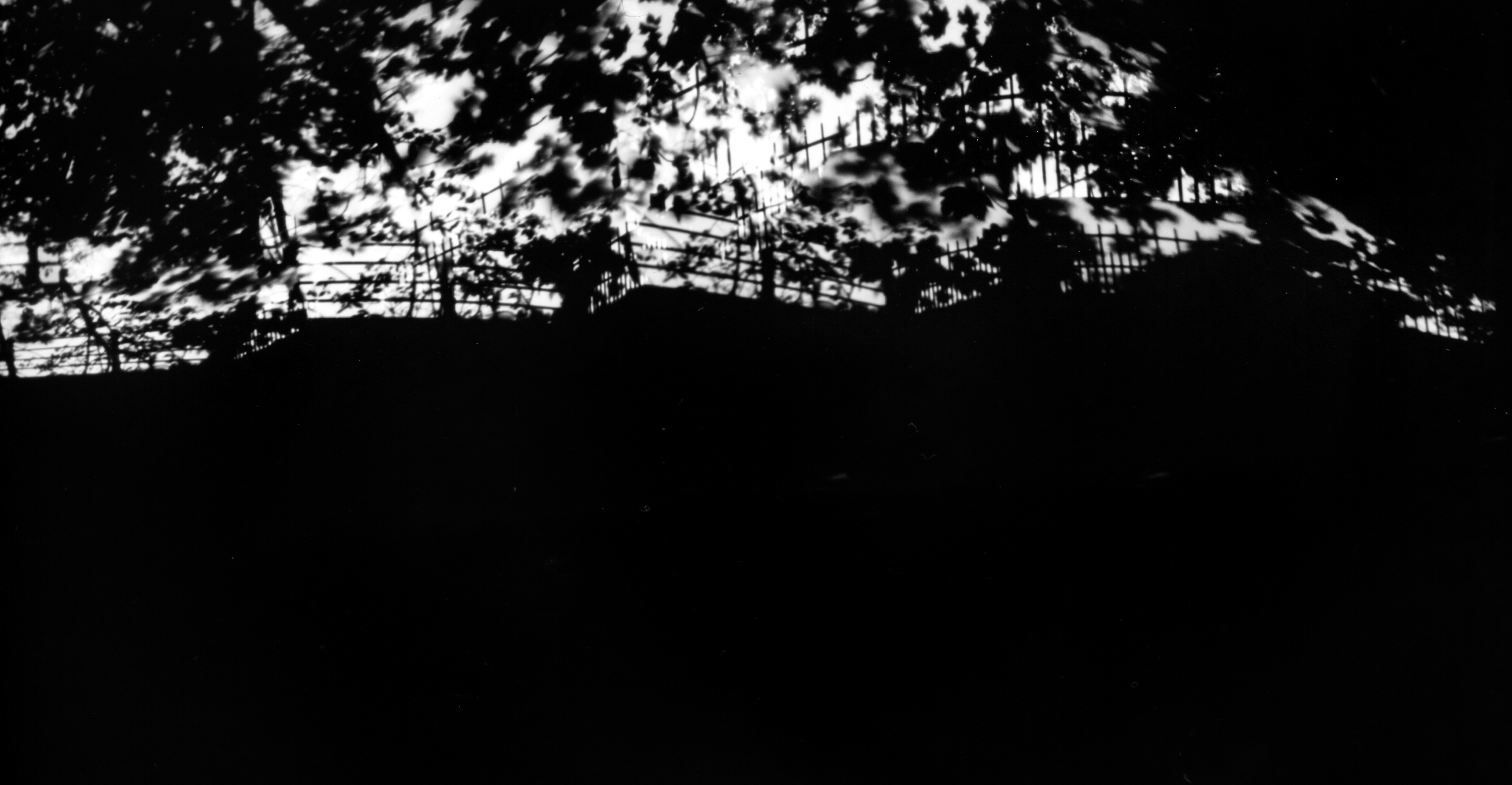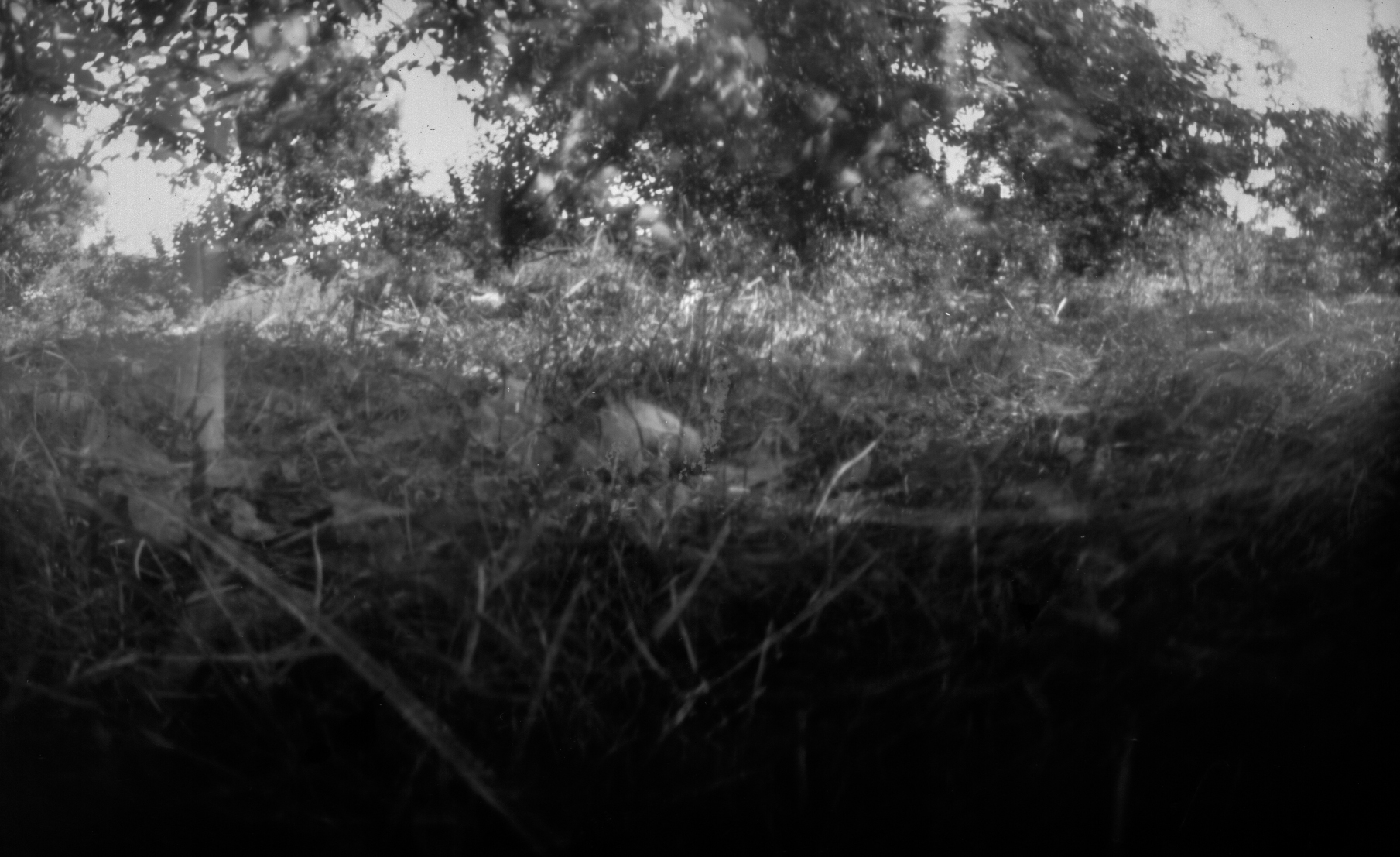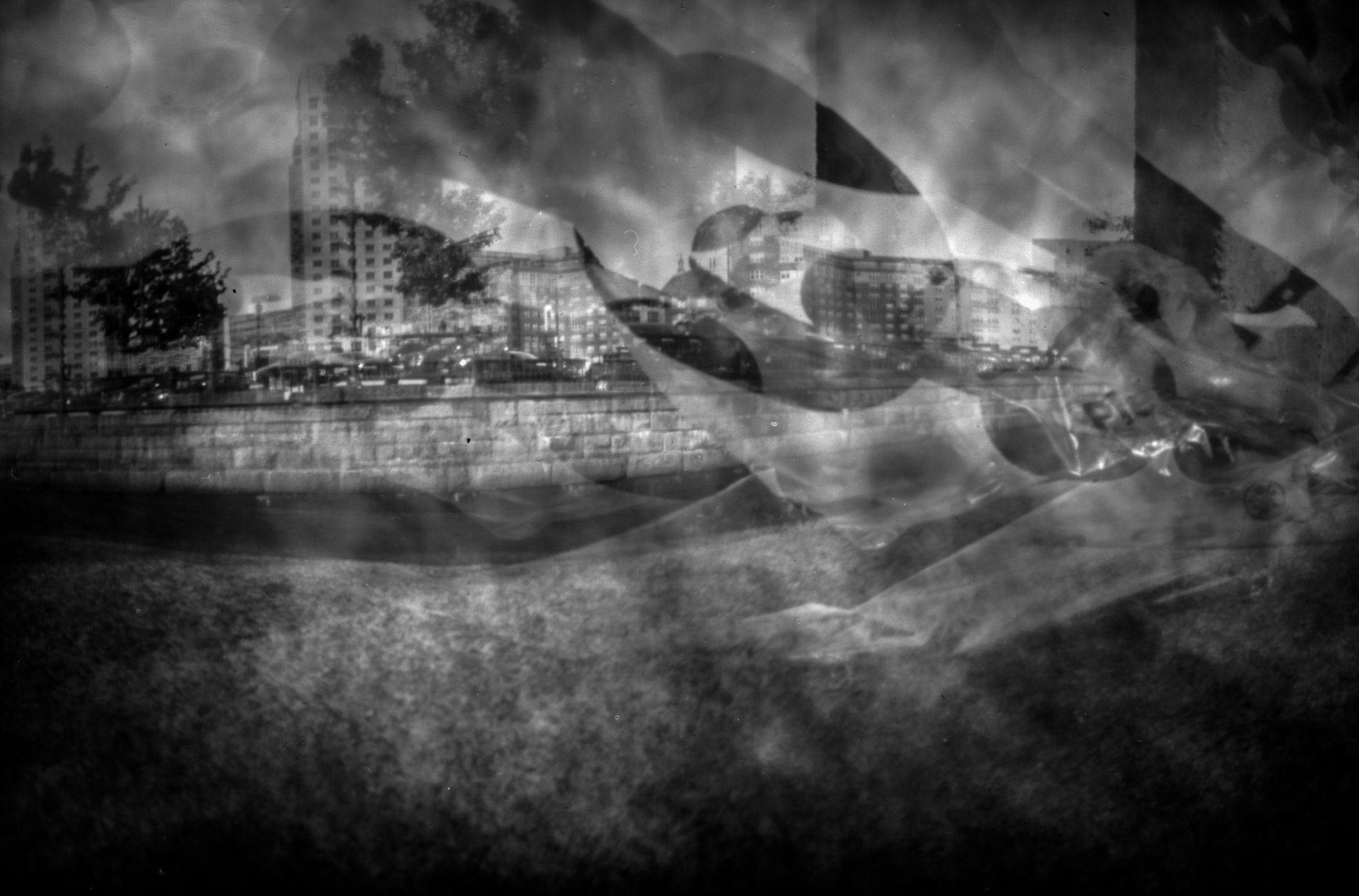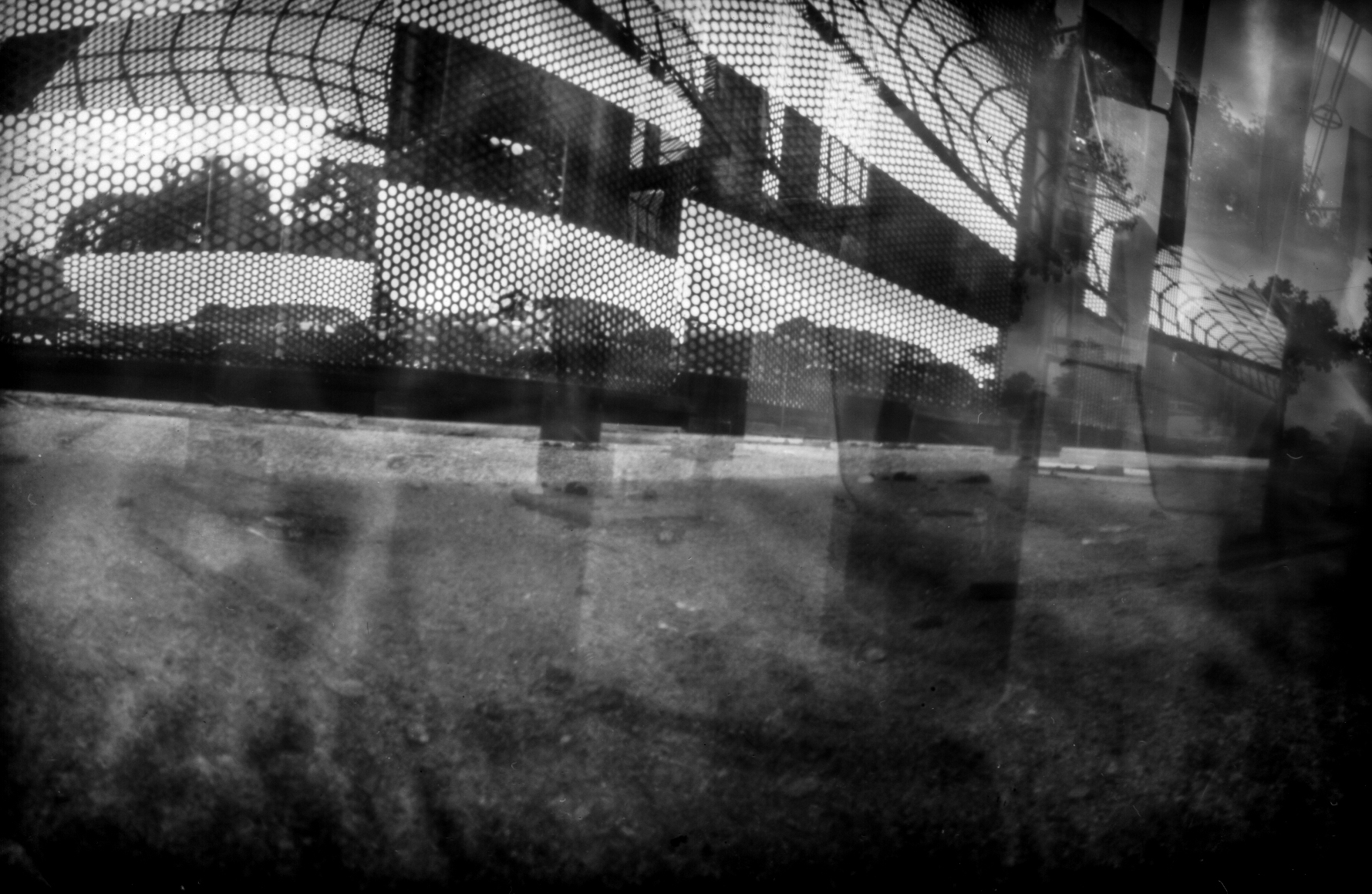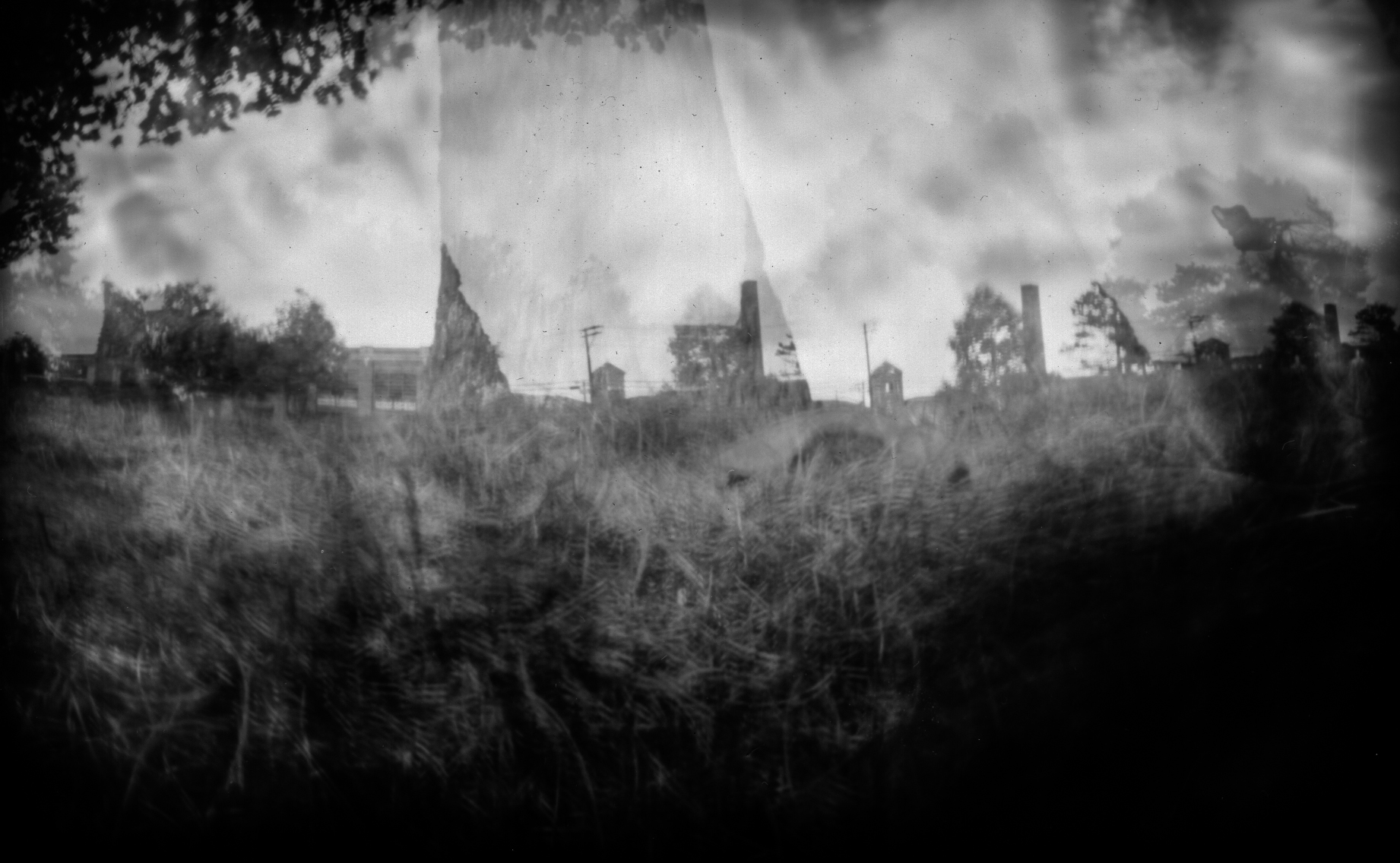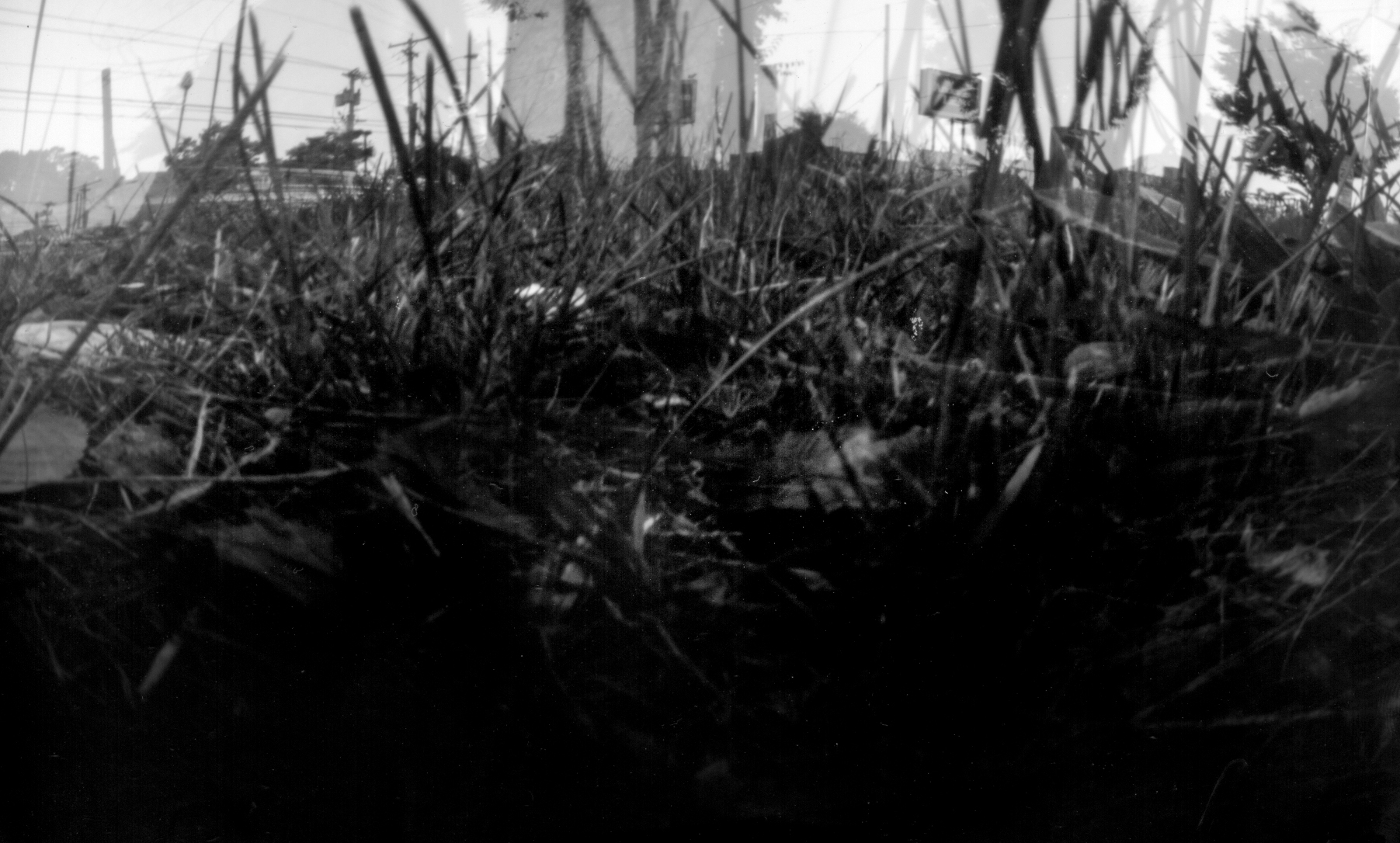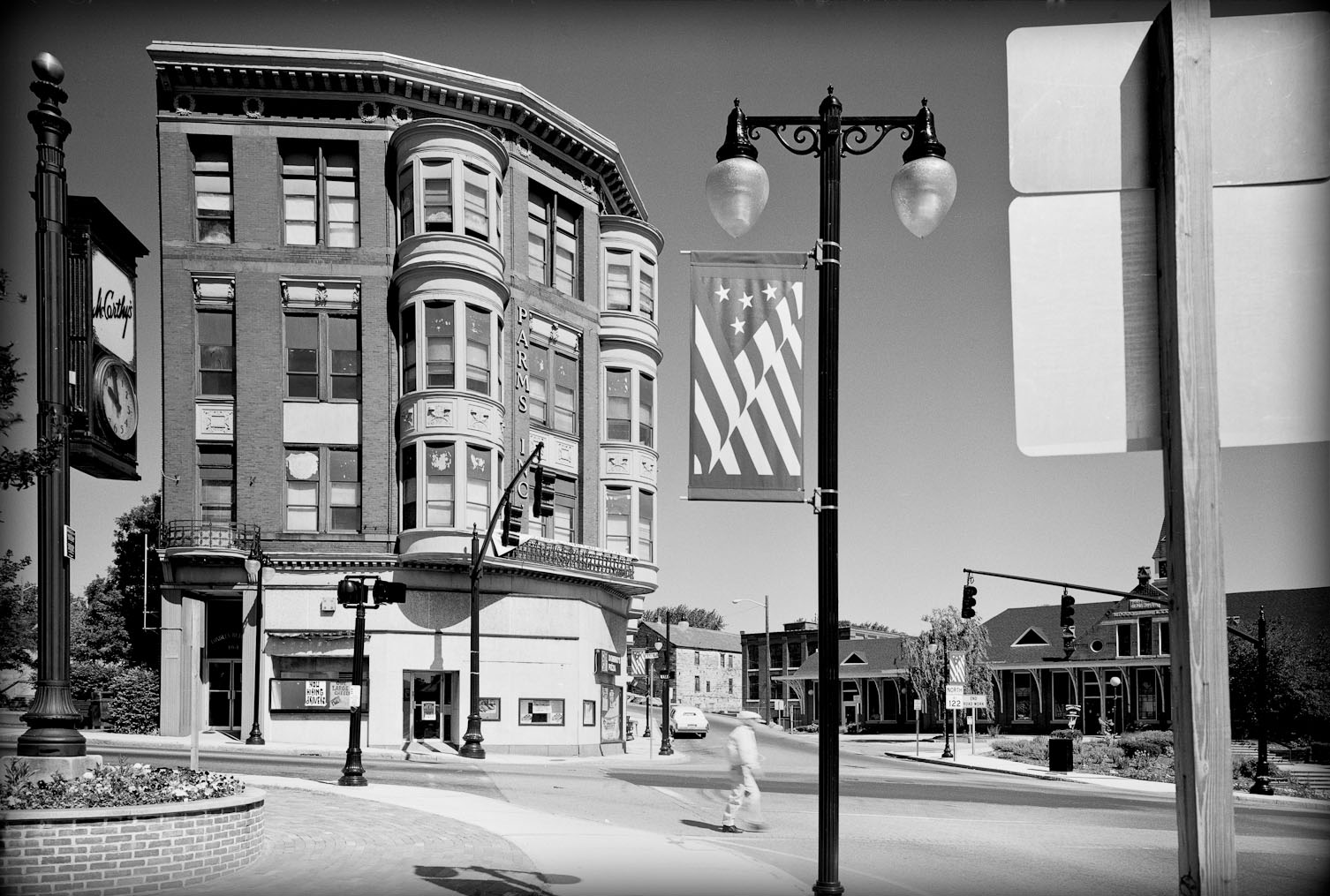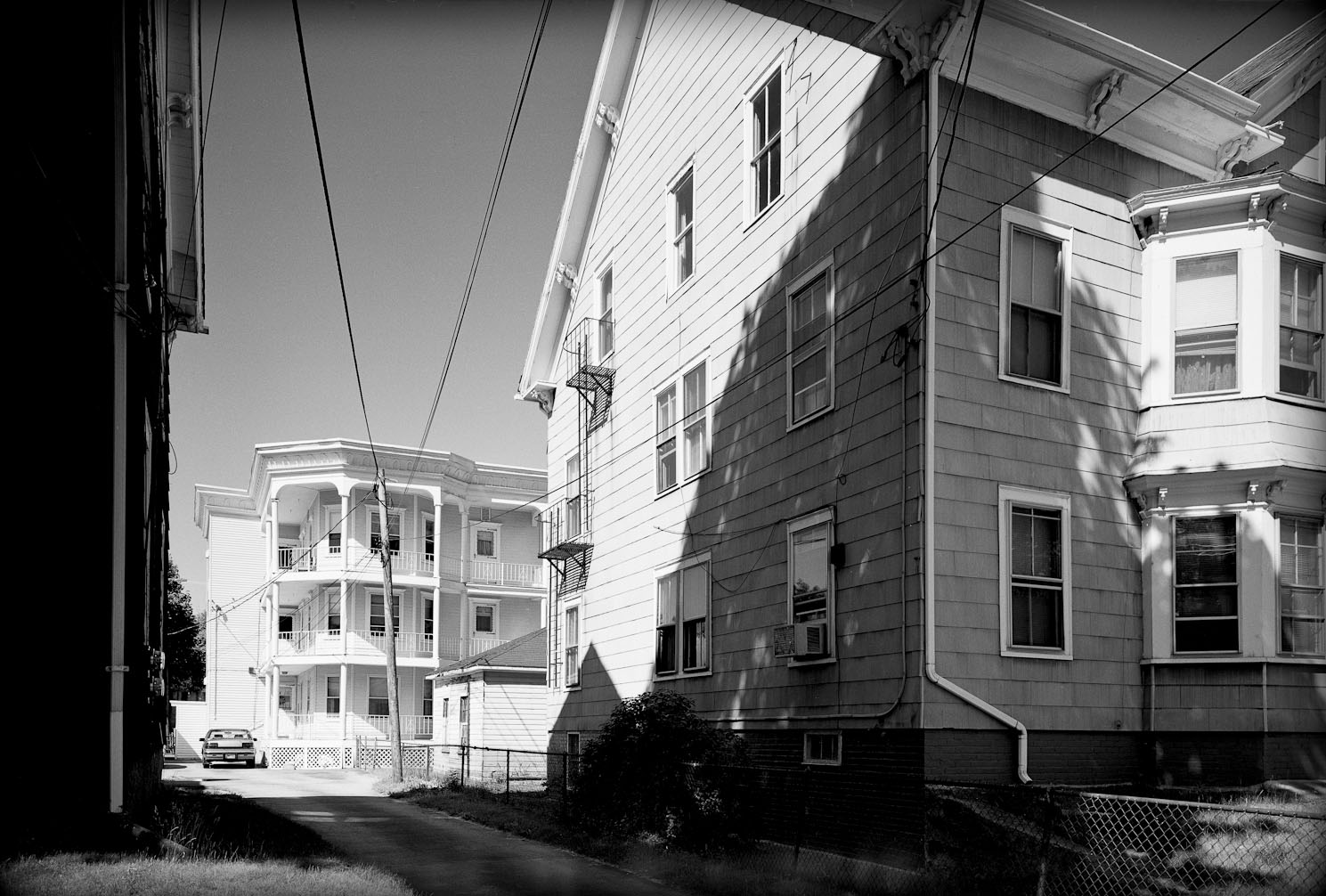Walking the hidden landscape of the Moshassuck river.
Read MoreMy life in half-frame. →
If you are fortunate enough to have a long relationship with photography you may find you have certain recurring obsessions that you can neither explain or fully control.
Read More0:00 on the Clock
As I have been putting this website together I've been going through the archives here at the Rhode Island Photographic Survey office looking for hidden treasure and rescanning old favorites. I've been paying attention recently to places that have been on Providence Preservation Society's Most Endangered list.
One of those sites is one that sadly has been torn down: the Providence Fruit and Produce warehouse that was on Harris Ave. I have scanned a number of images but this one caught my eye. Not because it's such a great image but because of a small detail that I've only just noticed now (or perhaps I had forgotten).
I call your attention to the upper right quadrant:
When this photo was taken in 1998 they had just begun to demolish the Providence Cold Storage building. This was the massive brick building behind the Silver Top diner. See the photo at the top of this post. The sign on the roof that spelled out the words Providence Cold Storage was dismantled letter by letter. Here only the "O" remains. "O". Zero, no time left on the clock for this piece of Providence.
Chimi Trucks on Broad Street
Photographs by Erik Gould, Adrienne Adeyemi and Sothdra Nguon-Devereaux
Audio recordings by Adrienne and Sothdra, audio montage edited by Erik
This photo essay is a collaboration of sorts between myself and two students I worked with while as a mentor at New Urban Arts, an arts based after school program for Providence high school students. Both Sothdra and Adrienne had assisted me on a project I did in partnership with NUA called the Providence Project. This was a neighborhood by neighborhood photo survey of Providence. We talked many times of going to take pictures of the Broad Street food trucks but during the time of the Providence Project we never did it. I so enjoyed doing photography with the two of them that during the summer before they both went on to pursue college careers we did a number of photo outings. Jesse Banks, studio manager at NUA, good friend and NUA alum also joined in. This trip to Broad Street was one of those outings.
On beautiful Providence July evening Jesse, Adrienne, Sothdra and I set out for Broad Street on Providence's South side to visit the Chimi trucks that set up there nightly. These mobile food vendors park along a stretch of Broad Street from Trinity Square to the Cranston line. I have long had an interest in these food trucks, they seem emblematic to me of new Americans making their way in business, working with what they know and what they have, free of corporate franchises. As a photographer I'm always on the look out for the hand-painted sign and the owner-operated business, that's where you the best stuff. We found a lively energy around these trucks and in the various shops up and down the street. People gathered to talk and hang out, guys with flashy cars would come by to show off. Music came from all over.
We talked about the contrast between that energy and the more subdued atmosphere we found in some other city neighborhoods we had photographed, which are really just a few blocks away. That is something else that I notice about Providence: Providence people keep to their own neighborhoods and they often don't know much of what's happening a few streets away. The Chimi truck scene couldn't be more public but I think many people who live in other neighborhoods would have no idea what I mean if I asked "what do you know about La Casa Del Chimi?" Well, I'm no Chimi expert either so that's why we went over to check it out. As for the Chimi sandwich itself, just like the hot dogs at the ballpark, all food tastes better when eaten out of doors on a summer night.
This piece is also an example of another idea: looking at one scene or one event from multiple points of view and with different recording media. Here we have 4 photographers, one with a big 8x10 camera on a tripod, the other's with more mobile cameras and digital audio recordings. These different sources reflect our individual points of view and also explore the ways that different materials produce different renditions of seemingly the same subject. This aspect of documenting the documentation and looking at how the actions of recording can change the event is something I have often examined and is central to much of my recent work. The 8x10 camera always attracts attention and Sothdra and Adrienne quickly became pros and dealing with interested onlookers while I got my pictures. Recording digital audio was originally Adrienne's idea and came out of many such experiences we had with passers by and the humorous, interesting and sometimes crazy remarks we would often get. The audio here captures street noise, conversation, music, and the steady roar of the Chimi truck generators. Inexplicably it also includes me saying the name "Pee Wee Herman." Have a listen.
Almost lifelike
Photos from a can
We replaced the regular camera in this photographer's bike bag with one made from a decaf coffee can. Let's see what happens:
All nestled all snug in it's bag...
It really is a camera.
The camera has my preferred 3 pinhole set up. I drill holes in the can and spray paint the inside flat black. I make pinholes in cinefoil which is just black aluminum foil, and then taped those in on the inside. Black tape for a shutter and all done. It's just that easy.
first test
I use photo paper to make paper negatives. This time out I've been trying different ways to reduce contrast so i can get some better tonality in the images. Photo paper is made to be exposed to lamps in the 3200K range. This is multigrade paper and in normal printing you manipulate the contrast by exposing through colored filters, altering the color of light over a range from magenta to yellow. So I taped some yellow filtration behind the pinholes to cut down on the blue (high contrast) light reaching the paper. I had some success.
I also diluted the paper developer by half to slow the process down and give lighter tones a chance to develop, which is only fair.
These pictures were made mostly along my bike commute in various locations in Providence, RI. September 2014.
Listen to the Pictures Part 2
Parts 1-4 of the audio piece created from field recordings made during the walks along the Moshassuck River. Recordings were made over a period of about 9 months.
Listen to the pictures: Conanicus' Bow audio
The full audio will be available on Saturday when the show opens.
Providence in Siver invades AS220 Project Space

 |
| Paul Shelasky hangs his excellent street work |
 |
| John Nanian hard at work |
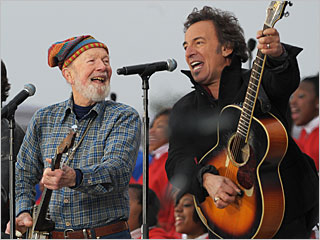 So long Pete, it's been good to know ya.
So long Pete, it's been good to know ya.Pete Seeger and Bruce Springsteen performing at the Lincoln Memorial Obama Inaugural Celebration Concert.
Much more great info here at Unionsong.com
New work: Conanicus' Bow @ AS220 Project Space

Opening on Saturday February 1st. Providence in Silver: photographs by John Nanian, Warren Eve, Paul Shelasky and Erik Gould @AS220 Project Space, Providence RI.
I'm very excited to be part of this group show and to show some new work. 40 photographs with text and audio.
A walking meditation, Conanicus' Bow grew out of my attempt
to walk the Moshassuck River, only 8.9 miles in length, flowing from Lincoln RI to the bay at Providence. Used and abused, this river makes its way almost unseen through a built landscape including former textile mills, a casket factory, three cemeteries, a major rail line and an interstate highway.
I relate my experience in photographs, words and field audio.
"Even under the open sky it is difficult to see and to get to, well guarded by a thicket of trees and vines and exit ramps. There's water there? Hiding in plain sight until comes a rainy spring and with great flood announces to the unlucky that although it may be your house or workshop YES indeed: a river flows (temporarily) through it..."
Available as a book on Blurb:
New work New book
More about this project soon.
Woonsocket RI / Working methods flashback
For Labor Day, A process flashback. I made a number of the pictures in Woonsocket RI with a baby Crown Graphic camera and 6x9 roll film back. I thought at the time that I wanted to continue a view camera method: camera on tripod, ground glass focus and framing, but with a smaller camera and 120 film. So I got a baby crown and a very nice 65mm Super Angulon lens. On 6x9 that works out to be very close to the same angle of view as a 28mm lens on a 35m camera. Perfect I thought. I got a bright screen to help with the focus, the SA was an f8 lens. I also got two graflex roll film backs, locating the later versions with the rollers installed. Should be quick and light, compared with a 4x5 or 8x10.
Still, even with the rollers in the backs I could see that that film flatness was less than ideal, in fact it was pretty bad. No problem I thought, the lens stopped down has such depth of field I won't have any problems with lack of focus. This was true. However the lens couldn't help with architecture turning into ribbon candy near the edges of the frame, in focus yes, straight no. For landscape it would be fine, but facades, not really.
This and the very limited range of movements brought this experiment to a close, but at least I tried it.
Always fun to wander around Woonsocket.
Crafting Photography for "The Dandy"

What goes into the making of a slightly different museum book.
http://risdmuseum.org/notes/crafting_the_photography_for_the_book_artist_rebel_dandy_men_of_fashion
10 Most 2012 edition
Sponsored by the Providence Preservation Society
Opening Reception, November 8
The Providence Preservation Society’s (PPS) highly acclaimed annual Ten Most Endangered Properties Photography Exhibit will appear November 8 – 29 at the Brick School House located at 24 Meeting Street, Providence. The show features the work of photographers Jan Armor, Jesse Burke, John Caserta, Michael Cevoli, Stephanie Ewens, Erik Gould, Heidi Gumula, Deborah Hickey, Tim Hiebert, Frank Mullin, and Traer Scott.
I photographed the closed florist shop and greenhouse at 398 Hope Street Providence.
http://www.ppsri.org/
9 years on
Last week was the 9th anniversary of the Station nightclub fire. On the evening of February 20, 2003 during a performance by the band Great White pyrotechnics ignited a fire that quickly destroyed the entire nightclub, claiming the lives of 100 people and injuring many more. I had never been there and I didn't know anyone who died that night but still I felt compelled to go there First of March I went to West Warwick and found the site. What was left of the nightclub, which was just a small wood framed structure, had been fenced off and the fence had become a makeshift memorial shrine. Flowers, notes, stuffed animals and photographs covered almost every surface. A neat row of crosses had been arraigned on one end. An early morning snow had turned to a cold rain, the light was grey. A few people walked about or stood in silence, stopping to read a note, sometimes adding something of their own. I've never felt such overwhelming sadness at a place. I walked the fence reading names, looking at faces in pictures. Ordinary faces in everyday snapshots, simple pictures now imbued with pathos.
 I was reaching my limit, aware that what ever I was feeling was nothing
compared to what others there that morning were confronting. I had my
camera and gave my self a little distance with the photographic
exercise. I shot one roll, just 8 exposures, recording simply the visual
facts before me. I then returned to my car and broke down in tears,
crying most of the way back to home. I was sad but I could leave and
return to my wife, my life would continue on as it has. Not everybody
was so lucky. 2 days later I developed the film, sleeved the negatives
and made a contact sheet. All of which I filed away until now.
I was reaching my limit, aware that what ever I was feeling was nothing
compared to what others there that morning were confronting. I had my
camera and gave my self a little distance with the photographic
exercise. I shot one roll, just 8 exposures, recording simply the visual
facts before me. I then returned to my car and broke down in tears,
crying most of the way back to home. I was sad but I could leave and
return to my wife, my life would continue on as it has. Not everybody
was so lucky. 2 days later I developed the film, sleeved the negatives
and made a contact sheet. All of which I filed away until now. Station nightclub wiki
Digging up a really bad idea

2008_ 013, a photo by e_pics on Flickr.
This sounds pretty stupid, even for TV. Robert O. Jones forwarded me this email from Ted Sanderson at the RI Historical Preservation & Heritage Commission:
"NEWS "Savage" Archaeology Loots History on Spike TV
2/24/2012
Setting a terrible example, Spike TV has announced a new television
program: "American Digger" that "follows the American Savage team, led
by former professional wrestler-turned-modern- day relic hunter Ric
Savage as they scour target-rich areas, such as battlefields and
historic sites, in hopes of striking it rich by unearthing and selling
rare pieces of American history."
In a press release, Spike TV says: "In the US, there are millions of
historical relics buried in backyards just waiting to be discovered and
turned into profit. “American Digger” hopes to claim a piece of that
pie as the series travels to a different city each week, searching for
high-value artifacts and relics. After pinpointing historical locations,
Savage’s first task is to convince reluctant homeowners to let his
team dig up their property using state-of-the-art metal detectors and
heavy-duty excavation equipment. The team will then sell any artifacts
found for a substantial profit."
As described, this TV program is wrong on so many levels. In some
jurisdictions, the actions described may be illegal if the land is
publicly-owned or regulated. In every case, digging up artifacts
removes them from the historical context in which they have meaning,
potentially destroys significant archaeological sites, and treating
artifacts as saleable commodities de-values the heritage we all share.
Beyond deploring what is essentially historical vandalism,
preservationists should be alert to "copy cat" diggers who may try to
search for artifacts and relics at historic properties without
permission. RIHPHC will be interested to receive information about any
artifact digging in Rhode Island."
Robert adds:
"I am utterly appalled by this.
I will draft a rebuttal immediately (as a citizen acquainted with proper archaeological procedures and artifact protection law).
Is the preservation community organizing counter-measures? NTHP should be all over this.
As soon as advertisers are identified, I will write them too . . . apparently this can prove very effective.
The implication that stealing (yes, stealing) artifacts & relics is a way to memorialize and show reverence for the past is both stupid and arrogant.
These Neanderthals just want to line their pockets with filthy lucre."
Here is a link to the Spike TV press release.
Curiouser Review -- Boston Globe
Bye bye Kodachrome
Sometime today the last roll of Kodachrome film will be developed at Dwayne's Photo in Parsons Kansas. It is the final end of an era. Much like John Lennon's quip about Elvis, for me they killed Kodachrome when Kodachrome 25 was discontinued. That was in 2001. In reality I had long before switched to E6 films.
I learned photography shooting Kodachrome. I took pictures of trains with my dad and my uncle John, in those days you weren't a serious railfan unless you were shooting Kodachrome. We shared images via slideshows and that's what the magazines wanted, not that I ever felt good enough to submit images to any magazines. The credit in the rail magazines wasn't just "photo by..." it was "kodachrome by ..."
I think shooting slides is a great way to learn photography, you see very clearly what changes in exposure can do, what differences in the color temperature of light can do, what color can do, what light itself can do. There was also that excitement in getting the yellow box, and the smell! Memories.
My family shot stills, slides, we didn't do home movies at all, so that is something I've come to later in my life. If you haven't had the experience, home movies on Kodachrome are amazing. Simple, magical slices of time. There really is nothing else like that. That ends today too.
I am happy to say that among the mountain of film that Dwayne's got this week is one roll of slides and three rolls of super 8 film from me. Film shot in tribute to the great American invention: Kodachrome, and for a life happily spent (so far!) in photography.
Farewell Kodachrome.
Camera Obscura by Design
ISB Parking lot - at the corner of North Main and Waterman Providence
across from the bus tunnel
10:00 to 3:00, rain or shine, free and open to the public.
check out some pics here, but better to see it in "real time".









